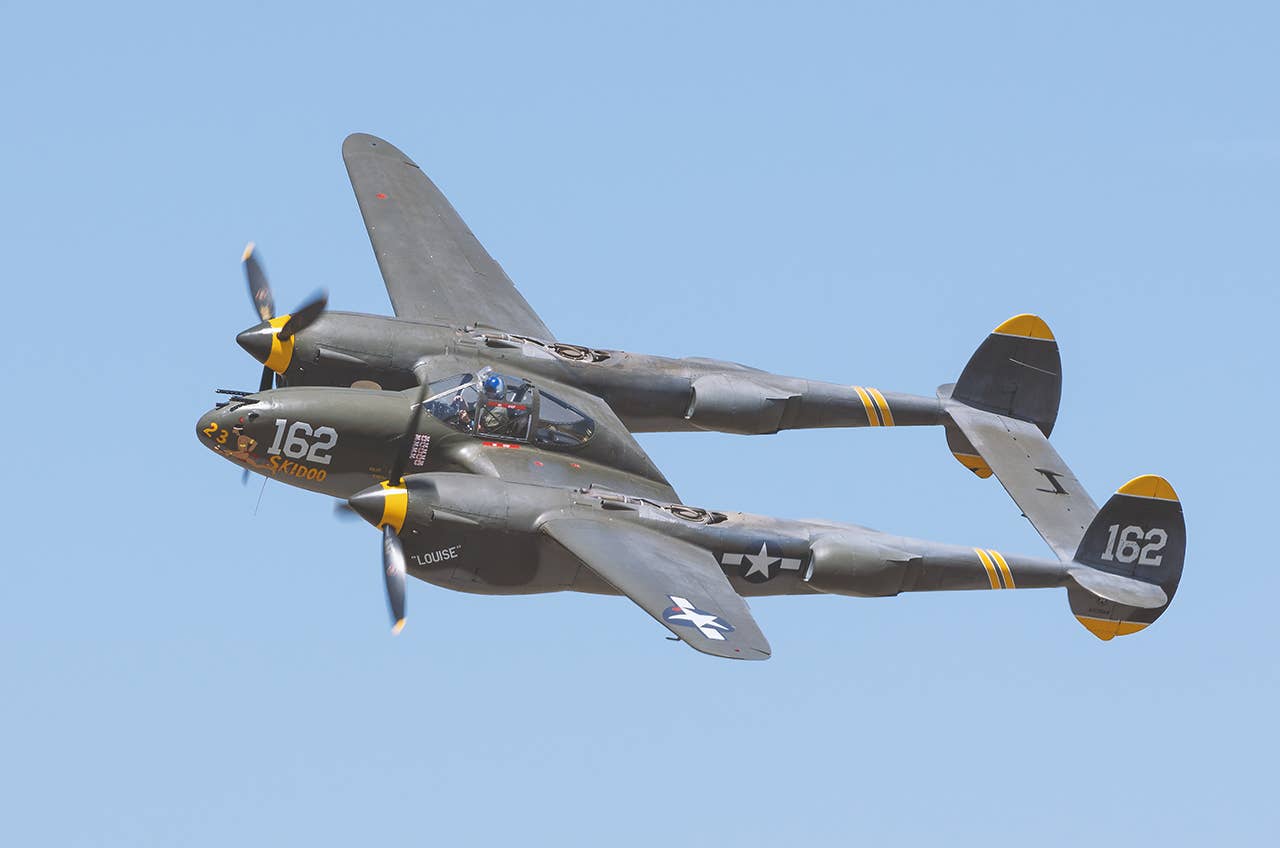Why Were P-38s Falling From The Sky?
The mystery deepened as new attempts to fix the problem failed.

Equipped with two turbosupercharged engines, enabling it to reach speeds greater than 400 mph and operate at altitudes exceeding 30,000 feet, the Lockheed P-38 Lightning was destined to be a game-changer in combat against Japanese fighters. Not just a dominant fighter, it would serve in multiple roles: a combination fighter-bomber, a night fighter, a long-range escort for heavy bombers and an important reconnaissance platform.
Despite its streamlined, all-aluminum structure and two 1,150-brake horsepower, water-cooled Allison V-1710 engines, the plane would suddenly become uncontrollable midflight for some strange reason. Upon entering a high-speed dive, the P-38's tail would begin to shake violently, and then the nose would abruptly tuck under. The flight controls would lock up, and the pilot could not control the aircraft as it plummeted toward the earth. Many pilots were lost. Some survived by bailing out, and a few lucky ones were able to regain control close to the ground.
What was happening to this sleek marvel of engineering?
Hearts Aflutter?
One of the theories at the time was that the P-38 was going out of control because it was experiencing flutter. Aeroelastic flutter is a divergent, harmonic vibration induced by inertial and aerodynamic forces on a flight surface. It is especially problematic with increasing speed and more elastic materials. Flutter becomes self-sustaining and will continue to worsen until the structure tears itself apart. By 1937, when the P-38 was being designed, flutter was already a well-known problem, especially as the more flexible fabric-covered aircraft and flight controls were pushed to fly at increasingly higher speeds.
Engineers, including Clarence "Kelly" Johnson, at Lockheed Corporation's top-secret Skunk Works, were well aware of the need to prevent flutter in the Lightning's design. The P-38 did not experience flutter largely because of the strength provided by the aluminum skin. When the mysterious P-38 behavior became a concern, Lockheed further discounted the flutter explanation with a series of experiments that included strengthening the tail with thicker aluminum and adding balance weights in different configurations. Despite these changes, the vibration---and mystery---remained.
Buffet, Anyone?
Another possibility was aerodynamic buffeting. At high speeds, an increase in vibration and shaking of the tail are also symptoms of buffeting, which could be caused by disruption in the airflow over the aircraft ahead of the tail. Lockheed discovered that adding filleting at the junction between the wing and the fuselage could smooth the flow of high-speed air at this point on the aircraft and eliminate buffeting. Fillet kits were sent out to P-38 squadrons for field installation on the P-38E and earlier models, and new production models included them at the factory. The buffeting was gone, but the vibration and control lockup was not.
Gremlins In The Forked-Tail Devil?
As early as 1917, the pilots in the British Royal Air Force began attributing unexplained damage and unknown problems with aircraft to gremlins. These little creatures allegedly infested an aircraft, causing everything from holes in the aircraft fabric to engine failures. After appearing in one aircraft, they would quickly spread to others in the squadron. Over time, gremlins spread to aircraft throughout the RAF, and by the time World War II broke out, the gremlin infestation reached U.S. Army Air Forces as well.
Whether superstition driven by the need to explain the unknown or just an amusing way to blow off steam, the myth of the gremlins spread across the globe and was attributed to malfunctions in every type of machinery.
Flying Into The Unknown
Was there really a sound barrier that aircraft could not break? As aircraft and engine designs evolved to allow planes to fly faster than ever before, more and more aircraft were coming closer to the speed of sound---767 mph at 68 degrees Fahrenheit. However, as pilots pushed the edge of this frontier in different types of aircraft, they reported strange instrument readings, the inability to move the controls or flight control reversal. As this realm of the unknown was approached, all the rules of conventional aerodynamics failed---sorry, Bernoulli! What was happening? Did the laws of physics set the speed limit at the speed of sound?
Compressibility
Ultimately, it was determined that the P-38 was experiencing compressibility effects. At low airspeeds, the air moving over an aircraft is incompressible and flows similarly to water moving past an object. However, at higher airspeeds, the air flowing over the aircraft will start to compress, and this compression increases as airspeed increases. If the airflow reaches the speed of sound, a shockwave will form that causes airflow to separate from the wing farther aft. This separation results in a sudden loss of lift.
The P-38 was not capable of supersonic flight. However, when it reached Mach 0.68---the plane's critical Mach number, the airspeed at which airflow over some of the flight surfaces reaches the speed of sound---it began to experience the effects of compressibility. For the P-38, this would cause the center of pressure to move aft as well as causing separation of airflow over the wings, resulting in a reduction of downwash at the tail. When that happened, the Lightning would abruptly nose over into a high-speed dive. Then, aerodynamic forces would essentially lock the flight controls in place, leaving the pilot helpless to do anything until the plane descended to denser air at lower altitudes. The increase in air density closer to the ground adds drag and slows the aircraft below its critical Mach speed. If sufficient time and altitude remain, the pilot can recover from the high-speed dive.
The problem with the P-38 first became known in May 1941, when Major Signa Gilkey, a U.S. Army Air Corps test pilot, experienced the loss of control and ensuing dive but survived. Upon reaching the denser air, he was able to break out of the dive using elevator trim. Early response to the problem was to train pilots to use trim and set limits on airspeed. While this was the best option to date, no one was satisfied it would solve the problem, especially in combat situations.
Lockheed tried adding servo tabs to the elevators of the P-38s to provide the pilots with additional control of the elevator at high speeds. Unfortunately, in November 1941, Lockheed test pilot Ralph Virden was killed in the high-G pullout after a dive while testing a servo-equipped Lightning.
Eventually, a high-speed aerodynamics expert, engineer John Stack of NACA (the National Advisory Committee for Aeronautics and NASA's predecessor), and Lightning designer Johnson determined that the problem could be solved by changing the geometry of the wing with the addition of fast-acting dive flaps. These flaps could be deployed in 1.5 seconds and would change the distribution of the pressure over the wing. With dive flaps installed, pilots could operate the aircraft at high speeds and still maintain control.
Early-model P-38s were retrofitted with dive flap kits, and later P-38 J and L production models had them installed at the factory. As a result, the P-38 became a reliable aircraft with excellent performance and long-range capability. It became a formidable combat aircraft, dominating as a long-range fighter in the Pacific theater as well providing invaluable photo reconnaissance in all theaters of operation.
The number of pilots killed in P-38s due to the compressibility effects is unknown. However, their experience with the Lightning has greatly contributed to our understanding of compressibility and high-speed aerodynamics, allowing planes and pilots to become better equipped to operate at the extremes. The development of supersonic wind tunnels and computer modeling has saved the lives of countless test pilots and has led to developments---such as supercritical airfoils, wing sweep, delta wings, and other innovations---that enable today's complex fighter aircraft to operate at more than twice the speed of sound.
Do you want to read more Mysteries of Flight articles? Enjoy "An SOS Call And A 40-Year Murder Mystery" here.

Subscribe to Our Newsletter
Get the latest Plane & Pilot Magazine stories delivered directly to your inbox






